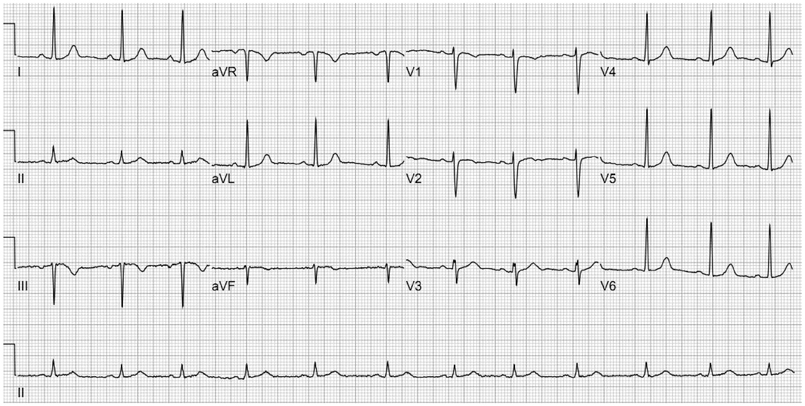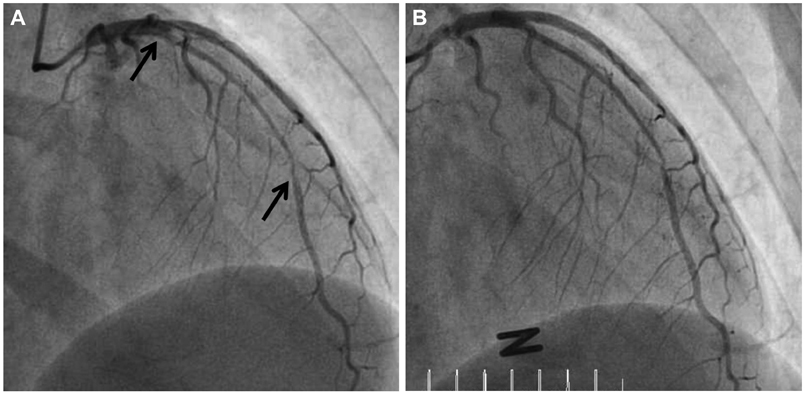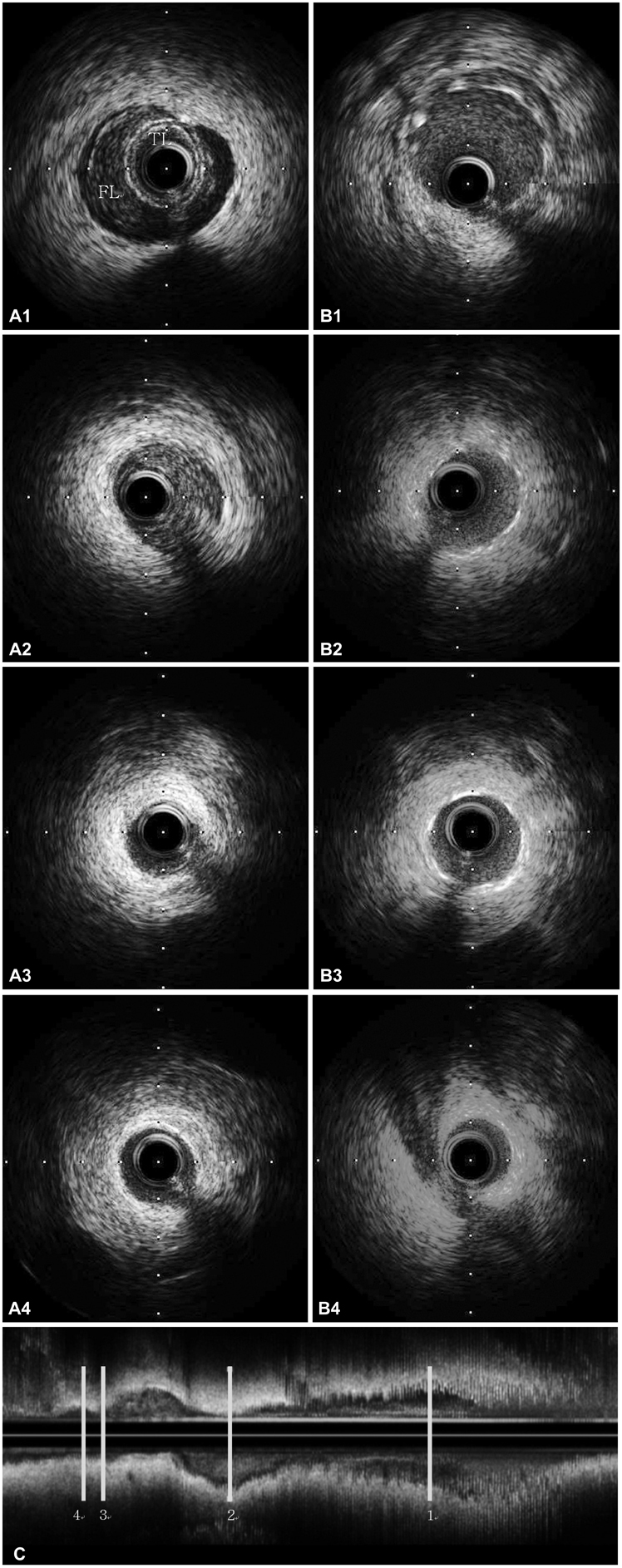Korean Circ J.
2013 Jul;43(7):491-496. 10.4070/kcj.2013.43.7.491.
Spontaneous Coronary Artery Dissection Mimicking Coronary Spasm Diagnosed by Intravascular Ultrasonography
- Affiliations
-
- 1Cardiology Division, Department of Internal Medicine, Gangnam Severance Hospital, Yonsei University College of Medicine, Seoul, Korea. cardiobk@yuhs.ac
- 2Cardiology Division, Department of Internal Medicine, Chungju Medical Center, Chungju, Korea.
- 3Cardiology Division, Department of Internal Medicine, NHIC Ilsan Hospital, Goyang, Korea.
- 4Cardiology Division, Department of Internal Medicine, Gachon University, Incheon, Korea.
- 5Cardiology Division, Department of Internal Medicine, Severance Hospital, Yonsei University College of Medicine, Seoul, Korea.
- KMID: 2145506
- DOI: http://doi.org/10.4070/kcj.2013.43.7.491
Abstract
- Spontaneous coronary artery dissection (SCAD) is a rare and occasionally life-threatening cause of acute coronary syndrome. Patients may present with clinical scenarios ranging from angina pectoris to cardiogenic shock to sudden cardiac death, and it may be a potentially life-threatening condition if not recognized. However, its etiology, pathophysiology and optimal therapeutic strategies have not been well understood. SCAD is diagnosed on the basis of coronary angiography, but complementary techniques as such intravascular ultrasound (IVUS) and optical coherence tomography should be considered for diagnostic clarification where appropriate. Likewise, the selection of treatment strategy depends upon the clinical manifestation, location and the extent of dissection and amount of ischemic myocardium at risk. Herein, we present the case of a 35-year-old woman who presented with acute myocardial infarction. She was diagnosed by IVUS with spontaneous diffuse dissection of the left anterior descending artery without atheroma, treated with percutaneous coronary stenting, and had a favorable clinical course and was discharged on medical therapy.
Keyword
MeSH Terms
Figure
Reference
-
1. Almeda FQ, Barkatullah S, Kavinsky CJ. Spontaneous coronary artery dissection. Clin Cardiol. 2004; 27:377–380.2. Pretty HC. Dissecting aneurysm of coronary artery in a woman aged 42. Br Med J. 1931; 1:667–669.3. Hering D, Piper C, Hohmann C, Schultheiss HP, Horstkotte D. [Prospective study of the incidence, pathogenesis and therapy of spontaneous, by coronary angiography diagnosed coronary artery dissection]. Z Kardiol. 1998; 87:961–970.4. Desai S, Sheppard MN. Sudden cardiac death: look closely at the coronaries for spontaneous dissection which can be missed. A study of 9 cases. Am J Forensic Med Pathol. 2012; 33:26–29.5. Tweet MS, Hayes SN, Pitta SR, et al. Clinical features, management, and prognosis of spontaneous coronary artery dissection. Circulation. 2012; 126:579–588.6. Adlam D, Cuculi F, Lim C, Banning A. Management of spontaneous coronary artery dissection in the primary percutaneous coronary intervention era. J Invasive Cardiol. 2010; 22:549–553.7. Gonzalez JI, Hill JA, Conti CR. Spontaneous coronary artery dissection treated with percutaneous transluminal angioplasty. Am J Cardiol. 1989; 63:885–886.8. Maehara A, Mintz GS, Castagna MT, et al. Intravascular ultrasound assessment of spontaneous coronary artery dissection. Am J Cardiol. 2002; 89:466–468.9. Paraskevaidis S, Theofilogiannakos EK, Chatzizisis YS, et al. Spontaneous dissection of right coronary artery manifested with acute myocardial infarction. Open Cardiovasc Med J. 2010; 4:178–180.10. Almafragi A, Convens C, Heuvel PV. Spontaneous healing of spontaneous coronary artery dissection. Cardiol J. 2010; 17:92–95.11. Borczuk AC, van Hoeven KH, Factor SM. Review and hypothesis: the eosinophil and peripartum heart disease (myocarditis and coronary artery dissection)--coincidence or pathogenetic significance? Cardiovasc Res. 1997; 33:527–532.12. Robinowitz M, Virmani R, McAllister HA JrU. Spontaneous coronary artery dissection and eosinophilic inflammation: a cause and effect relationship? Am J Med. 1982; 72:923–928.13. Jorgensen MB, Aharonian V, Mansukhani P, Mahrer PR. Spontaneous coronary dissection: a cluster of cases with this rare finding. Am Heart J. 1994; 127:1382–1387.14. Arnold JR, West NE, van Gaal WJ, Karamitsos TD, Banning AP. The role of intravascular ultrasound in the management of spontaneous coronary artery dissection. Cardiovasc Ultrasound. 2008; 6:24.15. Lerakis S, Manoukian S, Martin RP. Transesophageal echo detection of postpartum coronary artery dissection. J Am Soc Echocardiogr. 2001; 14:1132–1133.16. Regar E, Ligthart J, Bruining N, van Soest G. The diagnostic value of intracoronary optical coherence tomography. Herz. 2011; 36:417–429.17. Manghat NE, Morgan-Hughes GJ, Roobottom CA. Spontaneous coronary artery dissection: appearance and follow-up on multi-detector row CT coronary angiography. Clin Radiol. 2005; 60:1120–1125.18. Mortensen KH, Thuesen L, Kristensen IB, Christiansen EH. Spontaneous coronary artery dissection: a Western Denmark Heart Registry study. Catheter Cardiovasc Interv. 2009; 74:710–717.19. Vanzetto G, Berger-Coz E, Barone-Rochette G, et al. Prevalence, therapeutic management and medium-term prognosis of spontaneous coronary artery dissection: results from a database of 11,605 patients. Eur J Cardiothorac Surg. 2009; 35:250–254.20. Shamloo BK, Chintala RS, Nasur A, et al. Spontaneous coronary artery dissection: aggressive vs. conservative therapy. J Invasive Cardiol. 2010; 22:222–228.
- Full Text Links
- Actions
-
Cited
- CITED
-
- Close
- Share
- Similar articles
-
- A Case of Coronary Pseudostenosis, Diagnosed by Intravascular Ultrasound
- Two Cases of Spontaneous Coronary Artery Dissection
- Spontaneous coronary artery dissection by intravascular ultrasound in a patient with myocardial infarction
- Spontaneous Coronary Artery Dissection in a female patient with fragile X syndrome
- Spontaneous Coronary Artery Dissection and Woven Coronary Artery: Three Cases and a Review of the Literature




